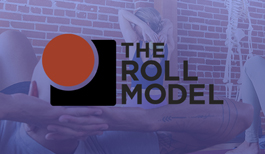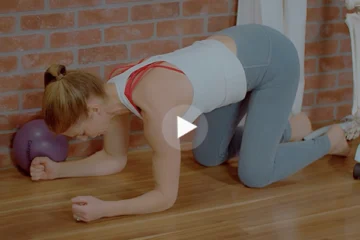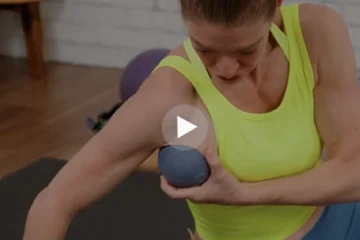
I returned home from YTU Level 1 training absolutely gleeful to introduce my clients to the wonders of YTU Therapy Balls. I bought a small case of them for my studio classes and to sell. I expected to be placing a reorder immediately as people clamored for Therapy Balls for family and friends after having used the balls in class. The balls sat in their shipping box, untouched and not touching anybody else.
Undaunted, I offered a special 90-minute YTU Therapy Ball-only Head-to-Toe Massage class. 2 people signed up. Afterwards they said it was ok, but doubt they’d take it again.
What’s wrong with you people? Their answer: it hurts.
While trying to address soft tissue, muscular and joint imbalances thru YTU exercises, all the shoulder flossing and pelvic primers in the world did not prepare my clients for the intense sensations they would encounter rolling around on the Therapy Balls. Despite the fact that they are taking care of themselves from the inside out, many of my clients do not receive manual massage on a regular basis and therefore aren’t used to precise, deep external pressure on their muscles. No wonder their full body weight on the Therapy Balls had my students glued to the ceiling, eyes popping out of their heads and gasping for air.

I felt like I was doing more harm than good, making them more tense, not less.
And so I began to modify. A lot.
In one case I physically rolled the balls on a client’s shoulders because she just couldn’t get into her supraspinatus effectively on her own.
For those clients who were supersensitive, I had them do every conceivable ball exercise against the wall. This was tremendously helpful for hips (ball between the glutes and the wall, roll a bulls-eye target on the gluteus maximus; stand sideways to a wall with a ball on the gluteus medius, make psychic bicycles) and spine (mow up and down the length of the spine—stop in a squat, make snow angel or firing squad arms and take both arms through a range of motion—also great thigh work as they hold those squats).
As the muscles most superficial to the skin began to relax and it was easier to go deeper with the ball work, I had clients come back to the floor, but layered a blanket between them and the Therapy Balls. While that made it a little tricky to move around on the balls, it allowed them to relax in one place on the spine and experience the sensation more gradually. Over time, we have removed layers of blankets and now the majority of my clients are able to work with the balls alone.
So much of this work is about meeting clients where they are to get them somewhere they never thought they could go. And now the balls are going home with them. In volume.
Get the YTU Therapy Ball Full Body Series and play with your props—change the orientation of the ball work they way you’d change the orientation of a pose! Your students will love your creative genius.
Learn about our Therapy Ball Programs.
Learn about Yoga Tune Up at home.












I just finished my YTU level 1 training and I will soon introduce the therapy balls to my dance students. This is a great reminder that this process of self-care takes time and that it is better to meet our clients where they are then to lose then altogether. Thank you!
I appreciate you sharing your story of introducing the YTU Therapy Balls to your classes. It’s wonderful that your tenacity has paid off and you were able to figure out modifications in order to make the Therapy Balls accessible to your students. Thank you for sharing the modifications.
What a great suggestion to use a blanket between the client and the therapy ball! I often suggest using balls on the wall but have never utilized a blanket. When I’m rolling in my personal practice at home, if there are particularly tender spots that I’m trying to tease, sometimes I even roll against a couch cushion or on my mattress. The glide on these surfaces is a little challenging, but it just gives some extra give until I can work my way up to the wall, or eventually down to the floor. It is hard work and it does hurt, but it’s a good hurt and a knowing that it’s making corrections in my body and in the bodies of others!
I’ve been toying on how to incorporate these into my classes! I will have to make sure to give wall options and others as well! Thank you for this post!
I love the question from my students, “Is this suppose to hurt?” I have now learned to warn them that they may experience some discomfort while on the balls. And to remind them that “the balls are not causing the pain the balls are showing them where their tightness resides” that is a statement that Maura Barclay always reminds us during any session of rolling. I also remind students about there breath and to make sure they extend their exhale. The adaptations I am learning in Level I are fantastic especially up in the shoulders. Once our students understand and feel the benefits they will want all of the balls.
Hi Christine – I just finished my first YTU training a month ago and I too bought a bunch of balls that I thought would fly out of my hands and into the wanting hands and body parts of my clients, so far it’s been slow going. But little by little i get requests to “do some ball work” and know that it will be coming eventually. Thank you for your honesty I found your post very reassuring.
Love this blog! After just spending a big part if my day 5 of my YTU training with YTU Therapy balls, I too had moments where the ball was barely tolerable. At other times they transported me into stages of bliss. This pretty much all was depending on how much pressure how soon. the key is to let the ball sink into the tissue slowly and give the underlying structures time to relax before too much pressure is applied. If the pressure is applied too hard too fats, the muscles will tense and stiffen resulting in pain and resistance. And this is something hard to palpate for others. This can be of a great challenge to a new teacher and frankly frightening. This article really helps! Thank you!
That’s a good point! Myself, I love deep massage with a strong touch for it’s the only way to really penetrate my muscles. We tend to forget not everyone like deep pressure. It is very true that the balls are extremely intense as they dig into the muscles. Variations at the wall will be a better approach for beginners until they get used to the intensity of the YTU balls.
I used the therapy balls for the first time today and they are unlike the massage experiences I’ve had – much more intense! I did find relief after and look forward to using them again but I think it is natural for people to avoid discomfort. I really like the idea of using the balls against the wall for greater control of pressure and will be trying that.
This is a great blog. This morning I brought my balls over to my father who suffers from terrible posture and pain in his back. He simply wouldn’t try the exercises because he said the balls didn’t feel good. I tried to explain that he’ll feel better once he had completed the exercise and that he was doing good in his body from the inside out but he refused. I’ll definitely use your blanket and wall techniques to see if I can ease him into it!
I agree with the comments as well. Using the Therapy Balls lying down can be a rather intense experience. In our Yoga Tune Up class, I did a lower back exercise that used the balls up against the wall and found it more enjoyable as it was easier to control the pressure when not using the entire weight of the body on the balls. I think it’s a good way to ease into the sensations and experiment with find different anatomical locations with less intense sensation.
I must agree with some of the other commentators experiencing fear towards the balls because of the pain. I think a lot of us turn to yoga to relieve pain and adding in therapy balls, while immensely pleasurable after use, is an unpleasant experience to willingly accommodate into our personal routines. The blanket and wall modifications make it sound more do-able, and equate to using props until our bodies can assume the final expression of a posture. Most of all, the idea of rolling the ball over a student for them allows them to sink into it more willingly, must like having someone else wax your eyebrows instead of going after each hair yourself and self-inflicting pain, so nice adjustments!
So I am a little late to the party on this blog post, but I was really happy to come across this one because I was one of those people for whom the pain was just unbearable, especially in the shoulders, when I first used the balls training with Jill. I have not touched them, out of fear mostly. But, now I’m excited to try the wall and blanket variations that you have outlined, which I would not have thought of on my own to prep myself. I would love to see a wall demo for placement, but Thanks for the idea Christine!
[…] it happened to be with Therapy Ball work (see my related blogs Good Things Come in Threes, and Balls to the Wall, and the Blanket, and…), but to me this illustrates a more important […]
The balls are a great tool for self massage and such an important tool for students for learn about their own bodies. I have used other “balls on the wall” almost exclusively because the hardness was indeed too much for areas with less tissue. Getting on the floor with the YTU balls (both one and two) and trying a blanket changed the whole experience.
And, the process of how you helped your students to break the tissue down in steps is inspired.
I have used the rolling balls on your body modification with my senior students and they love it- the wall is a great idea and I have not done that yet- what a nice way to transition from rolling the balls on your own body.
As far as the workshop numbers – I have learned to invite 3-4x more students than I expect and have no fixation on the outcome- the results are always just right.
Christine I used the blanket trick in class today for some students and it made a huge difference for them – definitely going into my arsenal!
The TYU therapy balls definitely takes some getting used to since they can produce really intense sensations in the muscles. I like the idea of manually rubbing the ball over a student in order to for her to experience some muscular release. The next progression with the blanket also lets students go deeper, but lessens some of the intensity from rolling directly on the balls. These modifications have inspired me to look for ways to modify the positions to best meet the needs of students.
I’m from Japan and it is a very common practice for people to receive a deep tissue massage. Like Shiatsu. In fact many people would ask for more pressure at the massage table. It’s interesting how people become accustomed to the pressure they receive in their bodies. I find in the USA, a lot of people are more sensitive to the touch. My husband can be like that, and his parents never had any body work done and they were not into it at all. So for people who are new to such intense physical sensation, your blanket modification sounds like an excellent choice, Thank you for sharing, I can’t wait to try it with my client.
That’s interesting- I teach at a power yoga studio, and I led my first “ball workshop” there this fall. (It was lacrosse balls, not YTU balls, and not a specifically YTU format, though that was a prime influence) Maybe it’s a difference in modality, but my people loved it- it almost sold out, and I still have folks telling me months later how much they love the balls. So, it will come!
This is such a great post Christine,especially as we were adressing these issue in today’s portion of teacher training.
It is so important to be able to help students who simply can not bare the the physical sensations they encounter while using the YTU therapy balls.
In my experience I have seen students who do carry lot of weight on their upper back to be truly in an excrutiating pain when they are faced with the UPPER BODY series-especially when their balls are getting to the attachment of T2-T5,rubbing through their ramboids major attachment.Would you have any idea on the continuency of this?
I find that good explanation of what is happening, and why it hurts helps people to relax about the sensations. Re-assurance that the action will not harm them (perhaps hurt them) also helps. Speaking to benefits – specifically – not just that “it is good for you” also can be quite powerful. Often we can endure much if we know it is for a “great cause”! All charitable organizations know that! They do not ask for your money to help those in need. They talk about this particular Michael who has two sisters (Anna & Monica), whose father has died Michael is 7 and has to walk 10 miles to school…. etc. We need specific, to excite, to invite, to “sell” the concept.
I love the modifications offered – they are awesome. Sometimes all we need is to modify the attitude about pain or discomfort. You can learn to love it…. well, up to a point. Watching intelligently strong sensations in the body is indeed sensational!